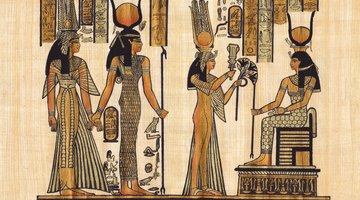The roles of women differed greatly among the ancient societies of Egypt and Mesopotamia, whose territories make up what is now Iraq and parts of Iran, Turkey and Syria. For the most part, ancient women in Egypt enjoyed more rights and privileges than their Mesopotamian counterparts in matters of marriage and property ownership.
Women's Legal Rights in Ancient Egypt
Ancient Egyptian legal rights extended to women in most situations, which made the nation's societal structure more egalitarian than most others of the time. Like men, women could buy, sell and manage property. They had ownership rights and could acquire commodities such as livestock, money, goods, slaves and servants. Egyptian women could work outside of the home and build wealth. They would inherit a third of their husband's estate in the event of his death. The structure of ancient Egyptian society also gave women the right to sue and play an active role in legal proceedings.
Women's Legal Rights in Ancient Mesopotamia
Women could not exercise much personal sovereignty in ancient Mesopotamia. The social structure defined women in relation to their families. Society viewed a woman as her father's daughter or her husband's wife -- and not as an autonomous individual. Royal women or those from rich and powerful families enjoyed a greater degree of personal autonomy, in some cases. Mesopotamian women would not inherit their husband's estate if there were eligible male heirs. Women did not often work outside of the house, but some held jobs selling wares they had created or worked as tavern keepers. The 18th century introduction of the Code of Hammurabi gave women the ability to divorce and own property under certain circumstances, even though the code also treated women as property.
Marriage for Women in Ancient Egypt
The government played a very small role in marriages in ancient Egyptian civilization, even though Egyptian society viewed marriage as a duty. The lack of state involvement in marital affairs meant that the circumstances and social standards of individual unions varied a good deal across classes and geographical areas. Egyptian law granted women the right to initiate and carry out divorces. Men sometimes gave gifts to the father of the woman they wished to marry in a manner that could be interpreted as purchasing her for marriage, but this dowry practice did not extend to all Egyptian marriages. Women retained ownership of their property upon entering into a marriage. Egyptian women usually did not enter a marriage until after menstruation had begun.
Marriage for Women in Ancient Mesopotamia
In ancient Mesopotamian, women were considered ready for a family-arranged marriage soon after they reached puberty. Mesopotamian women did not marry individuals; rather, they married into their husbands' families. The groom's father exercised considerable power in Mesopotamian marriages. For example, he could give the bride to one of the groom's brothers in the event of the groom's death or dissatisfaction with the marriage. The groom's family paid a dowry in most marriages, and Mesopotamian society viewed this as a payment for the groom's right to the bride. Husbands had the power to manage marital assets.
Related Articles
References
Resources
Writer Bio
Keith Noonan is a writer by day and a sleeper by night. His work has been published through The Motley Fool and Yahoo Finance.











